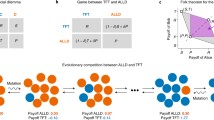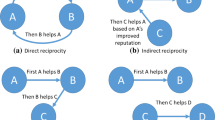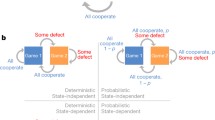Abstract
Previous game-theoretic models of reciprocity have assumed that populations are large and organisms effectively sessile. This paper analyzes an iterated prisoner's dilemma among non-sessile organisms in a finite population, on the assumption that an individual's chance of remaining in one place is not influenced by a partner's behavior. This mode of interaction is suitable for analyzing potentially cooperative behaviors that are secondary to the advantage of group formation, e.g. allogrooming among social mammals. The analysis yields necessary conditions for stable reciprocity in terms of three parameters, namely, a benefit/cost ratio, the probability of further interaction and the probability of partner retention. The results suggest that, in highly mobile organisms such as fish, birds and mammals, reciprocity may be stable only if the population is small and the relative benefit and future interaction probability are both large.
Similar content being viewed by others
References
Axelrod, R. 1984.The Evolution of Cooperation. New York: Basic Books.
Axelrod, R. and W. D. Hamilton. 1981. The evolution of cooperation.Science 211, 1390–1396.
Boyd, R. and J. Lorberbaum. 1987. No pure strategy is evolutionarily stable in the repeated prisoner's dilemma game.Nature 327, 58–59.
Clements, K. C. and D. W. Stephens. 1995. Testing models of non-kin cooperation: mutualism and the prisoner's dilemma.Animal Behaviour 50, 527–535.
Dawkins, R. 1989.The Selfish Gene, 2nd ed. Oxford. Oxford University Press.
Dugatkin, L. A. 1988. Do guppies play tit for tat during predator inspection visits?Behavioral Ecology and Sociobiology 23, 395–399.
Dugatkin, L. A., M. Mesterton-Gibbons and A. I. Houston. 1992. Beyond the prisoner's dilemma: toward models to discriminate among mechanisms of cooperation in nature.Trends in Ecology and Evolution 7, 202–205.
Dugatkin, L. A. and D. S. Wilson. 1991. ROVER: a strategy for exploiting cooperators in a patchy environment.Amer. Naturalist 138, 687–701.
Enquist, M. and O. Leimar. 1993. The evolution of cooperation in mobile organisms.Animal Behaviour 45, 747–757.
Feldman, M. W. and E. A. C. Thomas. 1987. Behavior-dependent contexts for repeated plays of the prisoner's dilemma II: dynamical aspects of the evolution of cooperation.J. Theor. Biol. 128, 297–315.
Ferrier, R. and R. E. Michod. 1995. Invading wave of cooperation in a spatial iterated prisoner's dilemma.Proc. Roy. Soc. London Ser. B 259, 77–83.
Hart, B. L. and L. A. Hart. 1992. Reciprocal allogrooming in impala.Aepyceros melampus. Animal Behaviour 44, 1073–1083.
Hart, B. L., L. A. Hart, M. S. Mooring and R. Olubayo. 1992. Biological basis of grooming behaviour in antelope: the body-size, vigilance and habitat principles.Animal Behaviour 44, 615–631.
Houston, A. I. 1993. Mobility limits cooperation.Trends in Ecology and Evolution 8, 194–196.
Levins, R. 1966. The strategy of model building in population biology.Amer. Scientist 54, 421–431.
Lorberbaum, J. 1994. No strategy is evolutionarily stable in the repeated prisoner's dilemma.J. Theor. Biol.,168, 117–130.
May, R. M. 1981. The evolution of cooperation.Nature 292, 291–292.
Maynard Smith, J. 1982.Evolution and the Theory of Games. Cambridges: Cambridge University Press.
Mesterton-Gibbons, M. 1992. On the iterated prisoner's dilemma in a finite population.Bull. Math. Biol. 54, 423–443.
Mesterton-Gibbons, M. and L. A. Dugatkin. 1992. Cooperation among unrelated individuals: evolutionary factors.Quart. Rev. Biol. 67, 267–281.
Milinski, M. 1987. Tit for rat in sticklebacks and the evolution of cooperation.Nature 325, 433–435.
Nowak, M. A., S. Bonhoeffer and R. M. May. 1994. More spatial games,Int. J. Bifurcation and Chaos 4, 33–56.
Nowak, M. A. and R. M. May. 1992. Evolutionary games and spatial chaos.Nature 359, 826–829.
Nowak, M. A. and R. M. May. 1993. The spatial dilemmas of evolution.Int. J. Bifurcation and Chaos 3, 35–78.
Packer, C. 1986. Whatever happened to reciprocal altruism?,Trends in Ecology and Evolution 1, 142–143.
Peck, J. R. 1993. Friendship and the evolution of co-operation.J. Theor. Biol. 162, 195–228.
Peck, J. R. and M. W. Feldman. 1986. The evolution of helping behavior in large, randomly mixed populations.Amer. Naturalist 127, 209–221.
Pulliam, H. R. and T. Caraco. 1984. Living in groups: is there an optimal group size? InBehavioural Ecology: An Evolutionary Approach, J. R. Krebs and N. B. Davies (Eds.), 2nd ed., Chap. 5, pp. 122–147. Oxford: Blackwell Scientific Publications.
Pulliam, H. R., G. H. Pyke, and T. Caraco. 1982. The scanning behavior of juncos: a game-theoretic approach.J. Theor. Biol.,95, 89–103.
Slater, P. J. B. 1994. Kinship and altruism. InBehaviour and Evolution, P. J. B. Slater and T. R. Halliday (Eds), Chap. 7, pp. 193–222. Cambridge: Cambridge University Press.
Stephens, D. W., K. Nishimura, and K. B. Toyer. 1995. Error and discounting in the iterated prisoner's dilemma.J. Theor. Biol.,176 457–469.
Wilkinson, G. S. 1984. Reciprocal food sharing in the vampire bat.Nature 308, 181–184.
Author information
Authors and Affiliations
Rights and permissions
About this article
Cite this article
Mesterton-Gibbons, M., Childress, M.J. Constraints on reciprocity for non-sessile organisms. Bltn Mathcal Biology 58, 861–875 (1996). https://doi.org/10.1007/BF02459487
Received:
Accepted:
Issue Date:
DOI: https://doi.org/10.1007/BF02459487




